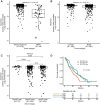Expression and Therapeutic Targeting of TROP-2 in Treatment-Resistant Prostate Cancer
- PMID: 36939530
- PMCID: PMC10261916
- DOI: 10.1158/1078-0432.CCR-22-1305
Expression and Therapeutic Targeting of TROP-2 in Treatment-Resistant Prostate Cancer
Abstract
Purpose: Men with metastatic castration-resistant prostate cancer (mCRPC) frequently develop resistance to androgen receptor signaling inhibitor (ARSI) treatment; therefore, new therapies are needed. Trophoblastic cell-surface antigen (TROP-2) is a transmembrane protein identified in prostate cancer and overexpressed in multiple malignancies. TROP-2 is a therapeutic target for antibody-drug conjugates (ADC).
Experimental design: TROP-2 gene (TACSTD2) expression and markers of treatment resistance from prostate biopsies were analyzed using data from four previously curated cohorts of mCRPC (n = 634) and the PROMOTE study (dbGaP accession phs001141.v1.p1, n = 88). EPCAM or TROP-2-positive circulating tumor cells (CTC) were captured from peripheral blood for comparison of protein (n = 15) and gene expression signatures of treatment resistance (n = 40). We assessed the efficacy of TROP-2-targeting agents in a mouse xenograft model generated from prostate cancer cell lines.
Results: We demonstrated that TACSTD2 is expressed in mCRPC from luminal and basal tumors but at lower levels in patients with neuroendocrine prostate cancer. Patients previously treated with ARSI showed no significant difference in TACSTD2 expression, whereas patients with detectable AR-V7 expression showed increased expression. We observed that TROP-2 can serve as a cell surface target for isolating CTCs, which may serve as a predictive biomarker for ADCs. We also demonstrated that prostate cancer cell line xenografts can be targeted specifically by labeled anti-TROP-2 agents in vivo.
Conclusions: These results support further studies on TROP-2 as a therapeutic and diagnostic target for mCRPC.
©2023 The Authors; Published by the American Association for Cancer Research.
Figures





References
Publication types
MeSH terms
Substances
Grants and funding
LinkOut - more resources
Full Text Sources
Research Materials
Miscellaneous

